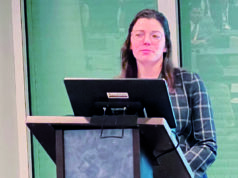
I have come up with a brilliant plan that will decrease the incidence of stroke nationwide, provide an excellent source of income for vascular surgeons, and reduce vascular surgeons’ stress and burnout. My concept is based on two recent trends in the management of patients at risk for carotid territory stroke.
First, medical management is now so advanced that it can prevent almost all strokes in asymptomatic patients. Therefore, prophylactic carotid endarterectomy or carotid stenting is now inappropriate and unnecessary, except, possibly, in patients with truly critical stenosis in the >90% range.
Second, according to a paper presented at the 2022 Vascular Annual Meeting (VAM), if surgery is performed, follow-up duplex scanning is unnecessary, since most patients will not develop a subsequent stroke, nor will they develop significant restenosis that requires revision. Thus, vascular surgeons face diminished income since they will not be performing large numbers of prophylactic carotid procedures, nor subsequent follow-up duplex scans.
My profoundly elegant concept is simple. Vascular surgeons must immediately stop performing highly-stressful carotid endarterectomy or stent procedures in asymptomatic patients. However, if high-grade stenosis is detected, they must continue to do six-monthly carotid duplex scans ad infinitum, just in case a truly critical stenosis is ultimately encountered. Since the reimbursement for a carotid endarterectomy is usually around $900, whereas the reimbursement for a duplex scan is approximately $150, equipoise in reimbursement will be achieved after just three years.
Thereafter, since the patient is unlikely to have a stroke, and therefore will likely live a long time, the vascular surgeon will make a stress-free $300 a year with ongoing testing. Rather than having to waste time going to the hospital, sit around waiting for anesthesia to see the patient and put them to sleep, worry that the patient will wake up stroke-free, and speak to the family and write the op note etc., they can now relax at the beach drinking a piña colada while they read the duplex scans on their laptop.
Further, they will no longer need to pay the exorbitant malpractice fees that are associated with the risk of carotid endarterectomy-related stroke, nerve injury and death. Concomitantly, the national incidence of stroke will fall precipitously, and everyone will be happy!
Russell H. Samson, MD, is a vascular surgeon at Sarasota Vascular Specialists in Sarasota, Florida. He is a 2020 recipient of the SVS Excellence in Community Practice Award and a former medical editor of Vascular Specialist.












This makes zero cents (ha ha ). Practice margin for a hospital-based CEA = 90% ($800).
Margin for carotid duplex = 20% ($30).
You need to do approx 25 ultrasounds for income equipoise. If q 6 months is the recommended surveillance interval, then you are talking 12-13 years of imaging.
The real solution to the problem involves value-based paradigms, not continued FFS models
My interpretation of Dr Samson’s piece is that it was written with a thick layer of sarcasm; however, it may not be taken in this light by some given its tone and the fact that there are those who would absolutely support this position. I think Dr Samson should make it clear in his next piece that this was not to be taken literally and that it was written sarcastically.
Always enjoy his writing.
Claude Roland MD
My brother is a vascular surgeon and he thought the same thing. Next time I’ll make it even more outrageous 😀